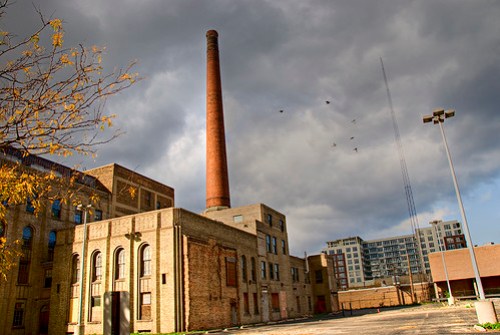
The Rise of the Creative Class
Find it hard to imagine Mayor Daley as a gourmet, but what do I know. I haven’t spent enough time in Bridgeport to know if there has been an influx of modern cuisine in the last couple years; my previous trips to the area encountered more hot dog stands and pizza parlors than anything else.
In the Chicago of Mayor Richard M. Daley, the most celebrated foods are more likely to be Kobe beef burgers, a Stanley Cup fashioned from chocolate and sashimi-grade Hawaiian ahi tuna with what Mr. Daley once described as “glacamole.”
The mayor’s pride in Chicago’s growing stature in the world of haute cuisine was on display again this week. After Mr. Daley spent much of last week in Idaho at a conference of the nation’s news media moguls, his next two public appearances in Chicago involved promoting the local gastronomy scene.
The mayor made a stop at the  French Pastry School on Monday to promote its expansion into new teaching kitchens at the City Colleges of Chicago. The school’s chefs had recently visited City Hall to present the mayor with a chocolate replica of the Blackhawks’ Stanley Cup trophy. The mayor beamed below the brim of a tall chef’s hat.
French Pastry School on Monday to promote its expansion into new teaching kitchens at the City Colleges of Chicago. The school’s chefs had recently visited City Hall to present the mayor with a chocolate replica of the Blackhawks’ Stanley Cup trophy. The mayor beamed below the brim of a tall chef’s hat.
On Tuesday, he joined about 50 chefs from many of the city’s fanciest restaurants at a news conference to promote the third annual Chicago Gourmet event, which will be held Sept. 25 and 26 at Millennium Park, a sort of Taste of Chicago for connoisseurs. Admission to the event, which attracted 3,000 people last year, is $150 a person.
“These chefs, to me, represent the creative class of society,” Mr. Daley said. “We have to realize how important they are to the city.”
The mayor clearly shares the theory, expounded in Richard Florida’s 2002 book “The Rise of the Creative Class,” that cities must attract people whose livelihoods involve imagination and innovation.
The culinary convention, Mr. Daley said, fits well with the city’s strategy of promoting itself as a destination for those seeking fine food and wine.
(click to continue reading Chicago News Cooperative – On Display, the Mayor as Epicure – NYTimes.com.)
Mayor Daley aside, there is certainly a large number of deliciously innovative restaurants in Chicago, which is probably why the Michelin Guide has added a Chicago edition, due for sale in November (not pictured).

Michelin Guide
Michelin will expand its exclusive restaurant and hotel guide series in North America to include Chicago. The MICHELIN guide Chicago 2011, the first-ever MICHELIN guide for a Midwestern city, will be published in November 2010. The announcement was made today by Jean-Luc Naret, worldwide director of the MICHELIN guide.
The MICHELIN guide, whose rating system is internationally recognized as the height of culinary success, is already published in 25 editions covering 23 countries, and additionally includes North America guides to New York City, which was introduced in November 2005, and San Francisco, launched the year after. The MICHELIN guide also recently launched titles in Asia, including two guides in Japan (Tokyo and Kyoto & Osaka) and Hong Kong & Macao.
The guide will provide a selection and rating, in all categories of comfort and prices, in a reader-friendly layout made especially for the American market and which reflects the region’s distinctive culinary and hotel landscape.

“The diversity, breadth and depth of Chicago’s restaurant and hotel scene, coupled with its rich gastronomic history, clearly mark the city and surrounding areas as the logical choice for the next North American title in the MICHELIN guide series,” commented Naret. “As with our recently updated guides to New York City and San Francisco, we are making every effort to produce a comprehensive selection that does full justice to the region’s exciting restaurant and hotel culture and also meets our readers’ expectations.”
During the announcement, Naret described Chicago as unique among American cities, citing its reputation as a world-class tourism destination and stressing the importance of its treasured culinary traditions.
…
“We are eagerly anticipating the MICHELIN guide’s entry into this wonderful city known for its cuisine, culture, beauty and innovative spirit,” said Naret.
As part of their meticulous and highly confidential evaluation process, Michelin inspectors – both European and American – are currently conducting anonymous inspections to Chicago restaurants and hotels. They’ve been in Chicago for two years. As with all MICHELIN guide inspections, the process involves test meals or overnight stays at each establishment, in order to assess the level and the consistency of the establishment. And as for all the other guides and all the other countries, the inspectors pay all their bills in restaurants and hotels.
“The Michelin inspectors are the eyes and ears of the customers, and thus the anonymity of our inspectors is key to ensure they are treated the same as any guest would be treated,” commented Naret.

(click to continue reading Michelin North America Newsroom.)
A tourist with discerning tastebuds could certainly spend significant time in Chicago, sampling food in different establishments, and not repeat any restaurants. There is so much to choose from, including even some scrumptious offerings from hot dog stands and pizza parlors. Food doesn’t have to be expensive to be good.


























